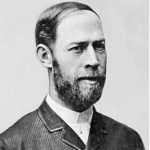Magnetic Personalities: Heinrich Hertz
Anyone who’s taken a science class has heard of “Hertz.” To refresh your memory, Hertz is the unit of frequency, with a cycle per second equally 1 hertz. The man behind the name is Heinrich Rudolf Hertz — a German physicist who discovered radio waves that had a tremendous impact on the world in the 20th century.
Background and Early Life
Heinrich was the eldest of five children, being born in Hamburg on February 22, 1857. It’s said that he was always interested in building things, reading scientific works, and doing experiments in his free time — as a teenager, he constructed a spectroscope and a galvanometer that were so well designed that he used them throughout his college years even. Originally, he planned to go into engineering. After working at the public works office, taking summer classes at the Polytechnic in Dresden, a year of military service, and working briefly in the engineering department at the University of Munich, he discovered his true passion — science.
In the winter of 1877, he got into his scientific studies and in the spring, he worked in a laboratory by working with Gustav con Jolly. At the same time, he enrolled in the University of Berlin, where he studied under the great German physicist Hermann von Helmholtz. During his time under Helmholtz, Hertz completed research and did a series of experiments to determine whether or not electricity moved with inertia. In August 1879, he won the prize for his evidence demonstrating that electricity had no inertia.
He then went to earn his doctorate degree in 1880, ahead of schedule and magna cum laude, after studying the induction produced by rotating spheres. Post-graduation, Hertz was a lecturer of theoretical physics at the University of Kiel but found himself dissatisfied, so he accepted a position at the Karl Polytechnic in 1995. He then worked at the University of Bonn in 1889, where he carried out his most important work.
The Work That Changed the World — Radio Waves
Between 1885 and 1889, he produced electromagnetic waves in the laboratory and measured their length and velocity. You can read about this in detail on MagLab, but in essence, he showed that the nature of their vibration and their susceptibility to reflection and refraction were the same as those of light and heat waves. As a result, he established beyond any doubt that light and heat are electromagnetic radiations. For a time, the waves he discovered were commonly referred to as Hertzian waves, but today they are known as radio waves. While he was not the first to produce such waves, he was the first to correctly understand their electromagnetic nature.
This showed that Scottish physicist James Clerk Maxwell’s theory of electromagnetism was correct and that light and heat are electromagnetic radiations — which paved the way for numerous advances in communication technology. Maxwell's equations united the fields of electricity and magnetism and comprised the first field theory in physics.
Other Work and Later Years
In addition to his radio wave breakthrough, he is notable for the discovery of the photoelectric effect, which he discovered while he was investigating electromagnetic waves. Though, he didn’t know this was what he discovered and it wasn’t until J.J Thomson and Albert Einstein discovered the ultraviolet radiation observed by Herz was the photoelectromagnetic effect.
In later experiments, he was able to calculate the speed of the radio waves he created, and found it to be the same as the speed of light. This discovery has led to so many modern developments, such as radio and television and Wi-Fi.
After 1889, when Hertz was teaching at the University of Bonn, he studied electrical discharges in rarefied gases and spent a significant amount of time composing his Principles of Mechanics. Unfortunately, at just 37 years old, he passed away due to complications related to blood poisoning and never saw the work published. Though, he knew how important his contributions were.
Learn More With Apex Magnets
We have a lot to thank Hertz for — in fact, you probably wouldn’t be reading this article without his contributions to society. For more blog posts about magnetic personalities through the ages, check out these blogs.

